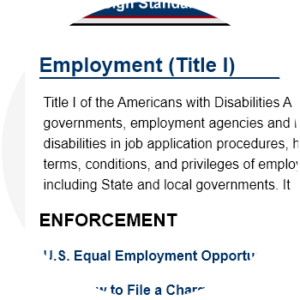
ADA Compliance
The Americans With Disabilities Act requires that certain businesses provide accommodations for people with disabilities. This means your website must be accessible by people who are blind, deaf, and those that navigate the Internet by voice, screen readers or other assistive technologies.

Title I Businesses
Businesses that fall under Title I, operate 20 weeks or more out of the year, with at least 15 full-time employees.

Prevent Lawsuits
Failure to provide the necessary ADA compliant features on your website can lead to lawsuits & financial liabilities.

Serving the Public
Most businesses that serve the public – including stores, restaurants, schools and museums – must comply with the ADA.
Your Business Is Almost Certainly Vulnerable to ADA Compliance Lawsuits
They’re calling it “Legal Extortion” and chances are excellent that your website doesn’t meet the necessary ADA compliance criteria.
And the most difficult pill to swallow is that they have a very real legal leg to stand on when they target your business and demand settlement money, often in the form of a check – checks that sometime reach as high as $75,000.
In 2019 alone, there were 2,285 ADA non-compliance lawsuits filed throughout the nation, and the majority of those lawsuits were filed in Florida and New York.
And the primary complaint from these plaintiffs is that they couldn’t navigate the website using a screen reader.
The genesis of an ADA compliance lawsuit
Typically, an ADA compliance lawsuit is filed towards a single website, by a lawyer on behalf of a client.
In the majority of cases, the lawsuit will indicate some inability to access parts of the website – be it captions on videos, keyboard accessibility or missing descriptions on hyperlinks.
The judges in these cases will require that the plaintiff demonstrate some sort of “harm”, where they were unable to carry out some basic function of the website, I.E. purchase an item, follow a link, or read an article.
What can I do to avoid these lawsuits?
In the short term, you’ll want to create a plan to upgrade your website to ADA standards within 60 days.
In fact, simply allowing us to put an ADA Compliancy Statement on your website can save you alot of legal headaches in the short term – although a plan must also be made to actually make the entire website ADA compliant.
And then what?
Give us a ring here at JPMicro: 850-470-8496, or fill out the form. We specialize in building ADA compliant websites (Not to mention business websites in general!) and upgrading older websites in order to become ADA compliant.
What are likely to be the consequences if I don’t make my website ADA compliant?
Failing to comply with the ADA means your business is susceptible to lawsuits, and it’s common for attorneys to seek out noncompliant businesses both in the physical and digital space, and the costs of ADA lawsuits can add up quickly.
Beyond regulatory consequences, failure to provide accessibility to users with disabilities means losing out on business. If users cannot navigate your website, you might be missing sales opportunities. Further, even if you’re not missing out on sales, ADA compliance makes it easier for search engines to crawl and index your website, pushing it up in the rankings and getting your web content in front of more users.
By making a good-faith effort to achieve reasonable accessibility for users with disabilities now, businesses can get ahead of the regulatory curve in developing a compliant website and avoid potential lawsuits. Moreover, designing a compliant website can lead to more sales and better ranking on search engines for a modest investment.
Copyright Pharr CPA © 2019 All Right Reserved. Design & Hosted by JPMicro.
